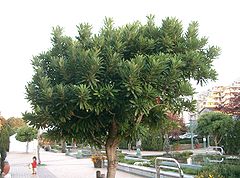Daphniphyllum
| {{{name}}} Daphniphyllum
|
'
| ||||||||||||||||||||||||||||||||||||||||
|---|---|---|---|---|---|---|---|---|---|---|---|---|---|---|---|---|---|---|---|---|---|---|---|---|---|---|---|---|---|---|---|---|---|---|---|---|---|---|---|---|---|

|
|
| |||||||||||||||||||||||||||||||||||||||
| |||||||||||||||||||||||||||||||||||||||||
| Standard Cyclopedia of Horticulture |
|---|
|
Daphniphyllum (Greek, laurel leaf, from the similarity of the leaves). Euphorbiaceae. Broad-leaved evergreen hardy or semi-tropical shrubs or small trees, sometimes cultivated for their handsome large foliage. Leaves large, without stipules, leathery, smooth, more or less glaucous, alternate, entire, petioled, pinnately veined: fls. dioecious, in axillary racemes or panicles, apetalous; calyx 3-8-parted, small, imbricate; stamens 5-18; pistil 2-celled, 4-ovuled: fr. a small, olive- like drupe, usually 1-seeded.—-Twelve to 20 species, mostly in Trop. Asia, etc. The one, or possibly two, species, rarely seen in cult, in Amer., are from Japan. The large evergreen Lvs. distinguish it from other hardy euphorbiacous shrubs. They are somewhat rhododendron- or laurel-like, hardy as far north as the Middle Atlantic States, and make very handsome broad-spreading shrubs with inconspicuous fls. Daphniphyllum can be propagated by cuttings, but roots rather slowly, and if seed could be secured it would no doubt give better results. The plants need protection from frost in winter till well established. They are strong growers in rich soil. Two other names, D. glaucescens, Blume, and D. jezoense, Hort., occur occasionally in horticultural literature. The first has scarcely glaucous Lvs. with lateral veins ⅕-⅓ in. apart and is probably not in cult.; the latter is a more dwarf form than the others. J. B. S. Norton.
|
Cultivation
- Do you have cultivation info on this plant? Edit this section!
Propagation
- Do you have propagation info on this plant? Edit this section!
Pests and diseases
- Do you have pest and disease info on this plant? Edit this section!
Species
Selected species:
- Daphniphyllum beddomei
- Daphniphyllum glaucescens
- Daphniphyllum macropodum - tree up to 10m
- Daphniphyllum teijsmannii - tree up to 10m
Gallery
If you have a photo of this plant, please upload it! Plus, there may be other photos available for you to add.
References
- Standard Cyclopedia of Horticulture, by L. H. Bailey, MacMillan Co., 1963
External links
- w:Daphniphyllum. Some of the material on this page may be from Wikipedia, under the Creative Commons license.
- Daphniphyllum QR Code (Size 50, 100, 200, 500)
